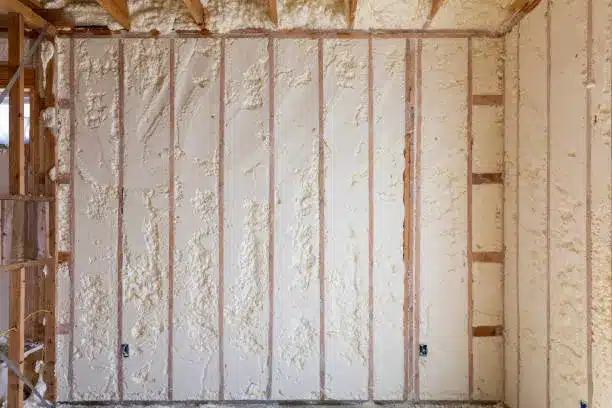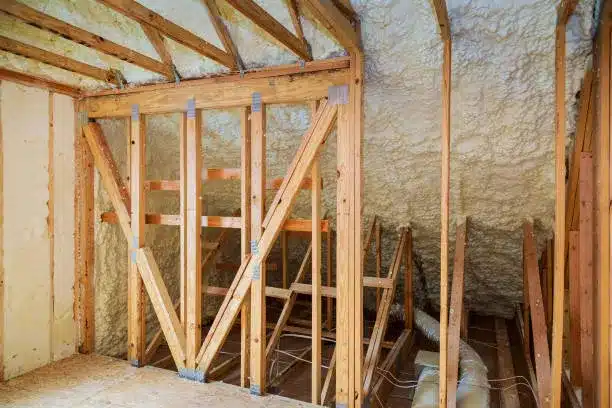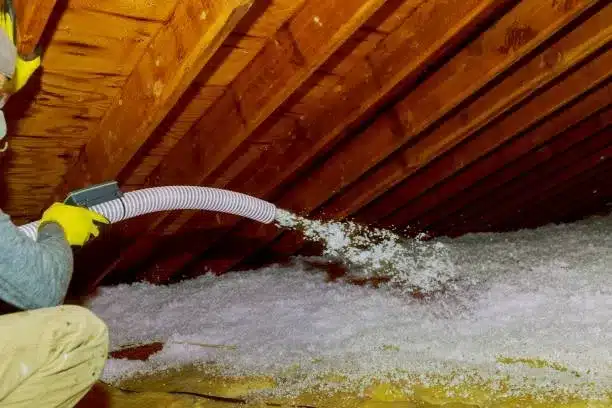Spray foam insulation is often the right choice for older homes in Grants Pass, OR, when energy loss through walls, attics, and crawlspaces becomes a consistent issue. Homes built before modern energy codes typically lack adequate air sealing, leading to drafts, uneven temperatures, and high utility costs. Closed-cell and open-cell spray foam both provide effective air sealing, significantly reducing heat transfer in aging structures.
Closed-cell spray foam is more effective where moisture intrusion, structural reinforcement, or limited cavity space is a concern. Open-cell is better suited for interior applications where sound absorption and vapor permeability are beneficial. For homes with outdated or failing insulation systems, spray foam often provides long-term thermal improvement with a single installation.
How Spray Foam Performs in Older Homes in Grants Pass
Grants Pass experiences a climate with hot summers, cold winters, and significant humidity swings. Older homes built before 1980 typically feature little to no wall insulation, leaky attics, and vented crawlspaces. These factors make them prime candidates for a modern insulation upgrade.
Spray foam offers both insulation and air sealing in one product, addressing:
- Infiltration from poorly sealed framing joints
- Moisture intrusion in crawlspaces and basements
- Uneven heating and cooling distribution
Bonus Tip: In homes with knob-and-tube wiring, confirm with a licensed electrician before applying spray foam. The product’s sealing qualities can create overheating risks if outdated wiring is concealed.
Comparison of Insulation Options for Older Homes
| Feature | Closed-Cell Spray Foam | Open-Cell Spray Foam | Fiberglass Batt | Blown-In Insulation |
|---|---|---|---|---|
| R-Value (per inch) | 6.0 – 7.0 | 3.5 – 4.0 | 2.9 – 3.8 | 2.2 – 3.8 |
| Air Sealing | Excellent | Very Good | Poor | Moderate |
| Vapor Barrier | Yes | No | No | No |
| Moisture Resistance | High | Low | Low | Low |
| Structural Reinforcement | Yes | No | No | No |
| Application in Tight Spaces | Effective | Effective | Limited | Limited |
| Sound Dampening | Moderate | High | Moderate | High |
| Retrofit Suitability | High | High | Moderate | High |
Source: U.S. Department of Energy, Building America Program
Technical Specifications and Installation Insights
| Specification | Closed-Cell Spray Foam | Open-Cell Spray Foam |
|---|---|---|
| Density | ~2.0 lbs/ft³ | ~0.5 lbs/ft³ |
| Expansion Rate | 30-50x original volume | 100x original volume |
| Application Temperature | 60-90°F | 60-90°F |
| Dry Time | < 10 seconds | < 10 seconds |
| Water Resistance | High | Low |
| Ideal Install Locations | Crawlspaces, walls, roof decks | Attics, interior walls |
Bonus Tip: Use closed-cell spray foam on rim joists to prevent air leakage and condensation in basements and crawlspaces prone to moisture.

Things to Consider Before Making a Decision
- Wiring and Plumbing Access: Spray foam hardens around obstructions. Ensure all electrical and plumbing work is complete before installation.
- Historic Features: For homes with historic value, consider how foam might affect wood breathability or restoration work.
- Budget Constraints: Spray foam has a higher upfront cost than traditional methods. Evaluate long-term savings from energy reduction.
- Existing Insulation: In some cases, spray foam can be installed over or in combination with old materials after evaluation.
- Ventilation Needs: Improved air sealing may require added mechanical ventilation to maintain indoor air quality.
Common Questions Before Installation
Is spray foam safe for older wood framing?
Yes, when properly applied and cured, spray foam does not degrade old wood. Closed-cell can even add rigidity to aging structures.
Does it require removing old insulation?
Only in specific applications. For example, attic floor insulation is often removed if foam is sprayed directly on the roof deck.
Can it be installed in wall cavities without removing drywall?
Only with specialized injection methods. Otherwise, wall access is needed.
What areas of older homes benefit most?
Attics, crawlspaces, rim joists, and unfinished basements usually show the highest improvement in energy performance.
Services Available for Older Homes in Grants Pass
All Foam & Insulation, LLC provides key insulation services suitable for older home retrofits:
- Closed-Cell Spray Foam: Best for crawlspaces, rim joists, and moisture-prone walls.
- Open-Cell Spray Foam: Ideal for attics and interior cavities where flexibility and vapor permeability are needed.
- Blown-In Insulation: Useful for supplementing attic insulation without structural changes.
- Fiberglass Batt Insulation: A budget-friendly option for accessible framing and wall retrofits.
Get Expert Insulation Guidance
For questions about whether spray foam is the right fit for your older home in Grants Pass, contact:
All Foam & Insulation, LLC
Phone: (541) 826-9600
Email: [email protected]
Receive practical recommendations based on experience with local building types, seasonal needs, and retrofit constraints.
FAQ About Spray Foam in Older Homes
How long does spray foam insulation last?
Spray foam typically lasts over 30 years without significant degradation.
Can pests damage spray foam?
It does not attract pests or rodents. It also seals off entry points they might use.
Is spray foam resistant to mold?
Closed-cell foam resists water absorption, reducing the risk of mold in damp areas.
How do I know if my old home qualifies for spray foam?
A professional inspection will determine cavity depth, framing conditions, and moisture risks.
Will spray foam reduce noise from outside?
Open-cell foam absorbs sound effectively, especially between floors and interior walls.





